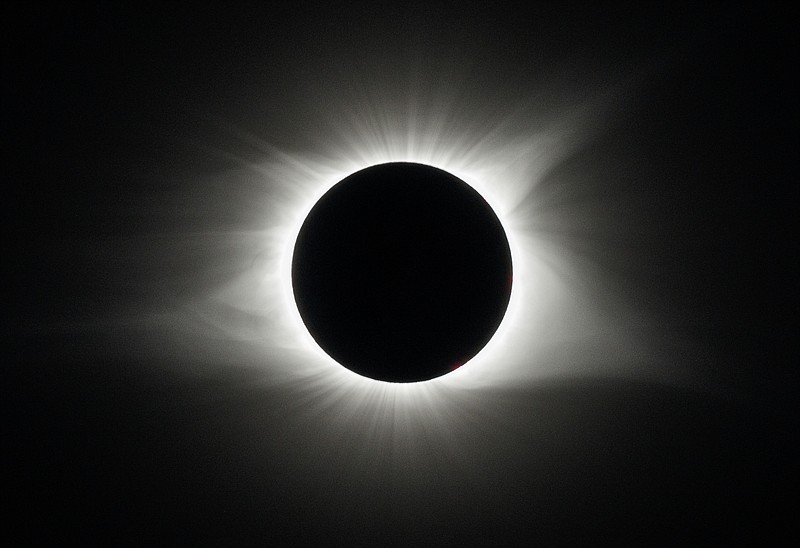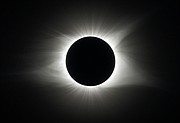This story was updated on March 30 to clarify that the last total solar eclipse was six years ago.
_____
One day next year, the moon will pass directly between the Earth and its sun, casting the shadow of a total solar eclipse across 12 U.S. states.
The April 8, 2024, total solar eclipse will just miss Tennessee's northwest corner as it traces a path in the U.S. across Texas, Oklahoma, Arkansas, Missouri, Illinois, Kentucky, Indiana, Ohio, Pennsylvania, New York and Maine, according to NASA.
For some who saw the last total solar eclipse six years ago on Aug. 21, 2017, it could be a chance to make it twice in a lifetime. That one was the first to cross the nation end to end in 99 years.
A total solar eclipse happens when the moon passes between the sun and Earth, completely blocking the face of the sun, according to NASA. People located in the center of the moon's shadow when it hits Earth will experience a total eclipse. The sky will darken, as if it were dawn or dusk, and the moon appears as a large black disk. A total solar eclipse is the only type of solar eclipse during which viewers can momentarily remove their eclipse glasses for the brief period of time when the moon is completely blocking the sun.
The millions who witnessed the eclipse on Aug. 21, 2017, should dust off those cardboard and plastic eclipse glasses that were so hard to find seven years ago, so they'll be prepared for the brilliant run-up to totality when they can strip them back off if they're lucky enough to be in the area of totality. After totality, it's also important to don them again as the sun begins peeking around the moon with its usual blinding brightness.
(READ MORE: Why is the eclipse longer in some places than in others?)
The 2024 eclipse, at around four minutes, 27 seconds, will be much longer than 2017's, which lasted around 2 1/2 minutes, according to NASA.
TOTALITY PATH
Mark Littmann, a University of Tennessee in Knoxville professor and author of "Totality: The Great North American Eclipse of 2024," said it's time for those who want to see it to start making plans. Next year's eclipse will be Littmann's seventh.
Littmann estimates almost 100 million people in the U.S. live in the path of totality or are within a 100-mile drive from either side of the eclipse path.
"Any total eclipse of the sun is a marvelous sight, but this one is especially interesting because it's longer than most eclipses. This one is considered a quite long eclipse," Littmann said Friday in a phone interview. "The total period of the eclipse at its maximum is four minutes, 28 seconds."
That will happen as the eclipse crosses from the Pacific Ocean over Mazatlán, Mexico, and travels northeast toward Maine. The longest period of the last total eclipse in 2017 lasted a maximum of two minutes, 40 seconds and happened when most of the U.S. had a clear sky, he said.
"So something like four minutes, 28 seconds is quite different and worth seeing," he said. "There's so much to see in those few, few moments that you really appreciate the extra time.
"The calculated maximum possible time of a total eclipse is seven minutes, 32 seconds, but there are no eclipses in the 21st century that last that long," he said.
The moon's shadow will trace a 2,140-mile path in the U.S., 705 miles in Canada and 535 miles in Mexico, according to Littmann. The path at about 101 miles wide in the U.S. and Canada will be considerably wider than 2017's eclipse shadow, which was closer to 70 miles wide.
(READ MORE: An eclipse chaser's guide to your first eclipse)
The next total solar eclipse of the sun on U.S. soil after 2024 will be in 2033 in Northwest Alaska, which is not very accessible and has some pretty dicey weather, so Littmann urges people not to miss their chance in 2024.
(READ MORE:Wear solar specs or make a viewer to safely watch eclipse)
"Whether you see it with just your family, by yourself or with a group, it's still wonderful," Littmann said. "But it's neat during the eclipse to hear people scream and shout and cry and applaud -- imagine applauding a solar eclipse -- but that's what happens spontaneously just because it's just such an unexpected, magnificent sight, as good as nature can create."
Littmann describes his strategy for viewing totality.
Viewers don't have to be on the central line of the moon's shadow but should avoid the edge of the path of totality, and look for a spot with a low horizon so the shadow is visible as it approaches.
"You can see the shadow of the moon building up like a giant thunderstorm on the horizon -- it's very dark -- then it flies at you at about 1,500 mph and just envelopes you, and then as the eclipse ends you can watch that shadow zip away at 1,500 mph," Littmann said.
LAST TIME
The total eclipse in 2017 was millions of Americans' first experience.
In Tennessee on Aug. 21, 2017, thousands upon thousands of native Tennesseans and visitors were able to see at least a partial eclipse, while those directly in its path in places like Clarksville, Nashville, Spring City, Cleveland, Decatur and Athens got the full experience as the roughly 70-mile-wide, 190-mile-long path of totality swept from west to east across the state.
In Southeast Tennessee, U.S. highways 27, 127 and 411 and state Highway 58 -- and Interstates 40 and 75 -- were jammed with cars filled with people seeking the best spot for a once-in-a-lifetime sight. The population for the day in Southeast Tennessee in places such as Athens and Spring City multiplied exponentially as thousands poured in to see the eclipse.
(READ MORE: Experts offer advice for taking eclipse photos with your smartphone)
One Chattanoogan who traveled a little way to see the 2017 celestial event is already getting ready for 2024.
"In August 2017, my wife and I saw the total solar eclipse at Edgar Evins State Park near Smithville, Tennessee," said Charlie Steinhice, a Chattanooga eclipse fan making plans to travel to the path of totality in 2024. "We could have seen totality closer than that, but it just so happened that a group of friends from around the country had booked cabins and a picnic shelter there to see the eclipse."
Steinhice's next taste of the spectacle will come a little over a year from now.
"Yes, I am absolutely planning to travel to the 2024 total solar eclipse," he said. "My wife and I will go. Right now, I'm debating between two options. The same group I met with in 2017 has a location picked out in Ohio. But we're seriously considering going to Niagara Falls -- I have no idea how many centuries it's been since a total eclipse passed over it. Unfortunately, that comes with a risk -- the weather's not so good there in April, and our view might be obscured by the mist. Plan C is that I have a friend in Texas, where better weather is more likely."
NO SUBSTITUTE
Littmann said there is no substitute for the human eye for viewing the eclipse, so don't settle for someone else's view. Even the best camera can't do the phenomena justice, just keep the eclipse glasses handy for before and after, he said.
(READ MORE: More than spectacle: Eclipses create science and so can you)
On April 8, 2024, the eclipse will start tracking across the continent a little after noon Central Time with totality reaching Dallas at 1:40 p.m. CDT, Little Rock, Arkansas, at 1:45 p.m CDT, Paducah, Kentucky, at 2 p.m., Cleveland, Ohio, at 3:13 p.m. CDT, Buffalo, New York, at 3:18, continuing northwest over Vermont and New Hampshire before leaving the U.S. over Caribou, Maine, at 4:40 p.m. EDT, according to NASA.
Contact Ben Benton at bbenton@timesfreepress.com or 423-757-6569.

